Analysis of the Urban Transformations Derived from Railway Housing Construction in Spain During Francoism (1939–1975): An Underestimated Heritage in Use
Abstract
1. Introduction
2. Materials and Methods
3. Results
3.1. The Design of the Housing Blocks. Forms, Typologies, and Dwellings Design (Cells)

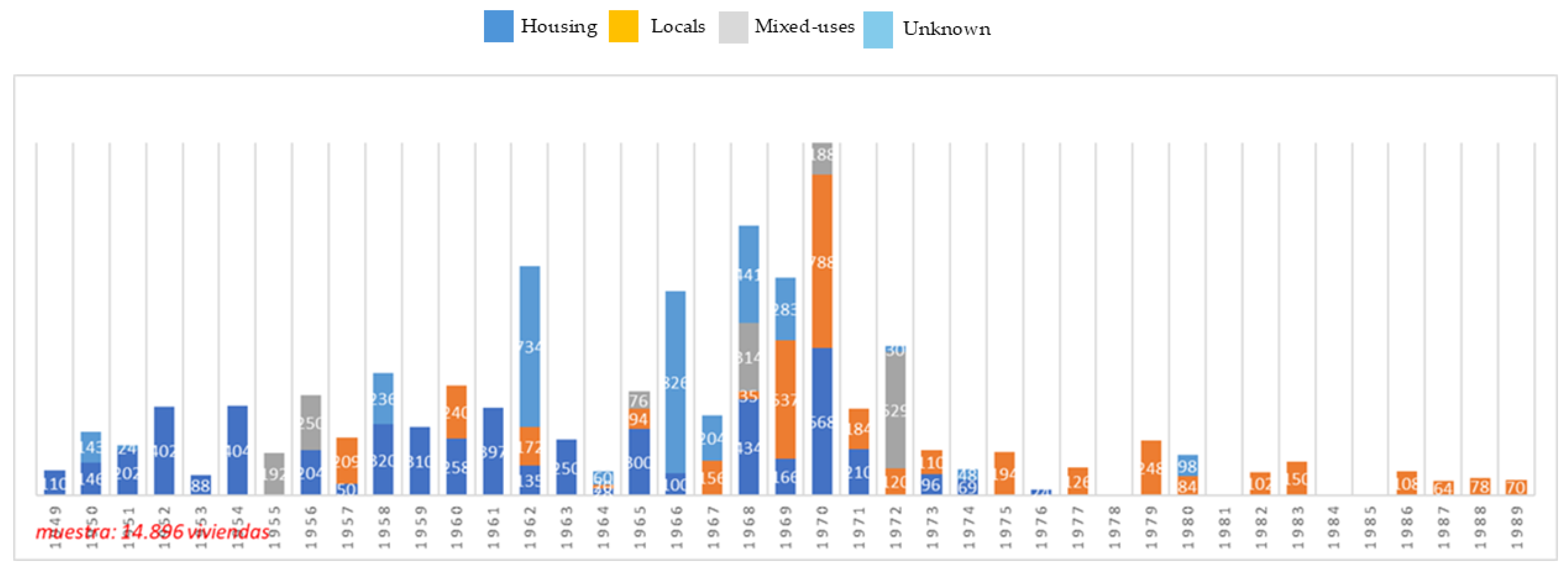
3.2. The Space Between Housing Blocks: Free and Community Spaces
3.3. The Location of Developments
4. Discussion and Conclusions
Supplementary Materials
Author Contributions
Funding
Data Availability Statement
Acknowledgments
Conflicts of Interest
References
- Carta de Nizhny Tagil.TICCIH. Carta de Nizhny Tagil. 2003. Available online: http://ticcih.org/wp-content/uploads/2013/04/NTagilPortuguese.pdf (accessed on 20 October 2024).
- S.a., Carta de Cracovia. Principios para la conservación y restauración del patrimonio construido. Astrágalo Cult. Arquit. Ciudad. 2001, 17, 127–134. Available online: https://dialnet.unirioja.es/servlet/articulo?codigo=2611196.pdf (accessed on 20 October 2024).
- ONU-Habitat. Web1. Available online: https://onu-habitat.org/index.php/vivienda-inviable-para-la-mayoria (accessed on 4 November 2024).
- Agenda Urbana Española. Web2. Available online: https://www.aue.gob.es/ (accessed on 4 November 2024).
- Agenda 2030 Web3: United Nations. New Urban Agenda. 2017. Available online: https://unhabitat.org/about-us/new-urban-agenda (accessed on 26 September 2024).
- Bertolini, L. Nodes and places: Complexities of railway station redevelopment. Eur. Plan. Stud. 1996, 4, 331–345. [Google Scholar] [CrossRef]
- Bruinsma, F. The impact of railway station development on urban dynamics: A review of the Amsterdam South Axis project. Built Environ. 2009, 35, 107–121. [Google Scholar] [CrossRef]
- Acker, M.V.; Triggianese, M. The spatial impact of train stations on small and medium-sized European cities and their contemporary urban design challenges. J. Urban Des. 2021, 26, 38–58. [Google Scholar] [CrossRef]
- Aguilar Civera, I. La Estación de Ferrocarril, Puerta de la Ciudad; Consejería de Cultura, Educación y Ciencia: Valencia, Spain, 1988; Volumes 1–2. [Google Scholar]
- López García, M. MZA: Historia de sus Estaciones; Centro de Investigaciones Sociologicas: Madrid, Spain, 1986. [Google Scholar]
- Sobrino, J. La arquitectura ferroviaria en Andalucía. Patrimonio ferroviario y líneas de investigación. In 150 años de Ferrocarril en Andalucía: Un balance; Consejería de Obras Públicas y Transportes: Sevilla, Spain, 2008; Volume II, pp. 823–885. [Google Scholar]
- Muñoz Rubio, M. RENFE, 1941–1991: Medio Siglo de Ferrocarril Público; Ediciones Luna: Madrid, Spain, 1995. [Google Scholar]
- Carreras, A.; Tafunell, X. La gran empresa en España (1917–1974). Una primera aproximación. Rev. Hist. Ind. 1993, pp. 127–175. Available online: https://raco.cat/raco/index.php/es/inicio/#gsc.tab=0 (accessed on 26 September 2024).
- Capel, H. Los “Ferro-Carriles” en la Ciudad Redes Técnicas y Configuración del Espacio Urbano; Fundación de los Ferrocarriles Españoles: Madrid, Spain, 2011. [Google Scholar]
- Santos y Ganges, L. Urbanismo y Ferrocarril. La Construcción del Espacio Ferroviario en las Ciudades Medias Españolas. Instituto Universitario de Urbanística: Valladolid, Spain, 2007; Available online: https://1drv.ms/b/s!Alw91UAhEipthq5Ju3VENIcTvHklpg (accessed on 20 September 2024).
- Aguilar Civera, I.; Navascués, P. Las Estaciones Ferroviarias de Madrid, su Arquitectura e Incidencia en el Desarrollo de la Ciudad. Servicio de Publicaciones del Colegio Oficial de Arquitectos de Madrid: Madrid, Spain, 1980. [Google Scholar]
- González Fraile, E. Las arquitecturas del ferrocarril: Estación de Valladolid. Ph.D. Thesis, Universidad de Valladolid, Valladolid, Spain, 1997. Available online: https://portaldelaciencia.uva.es/documentos/61567a86f4a2be56234420dc?lang=de (accessed on 27 September 2024).
- Usón, E. La Estación Internacional de Canfranc. Ámbit: Barcelona, Spain, 2004. [Google Scholar]
- Muñoz Fernández, F.J. La arquitectura del ferrocarril de posguerra en Bilbao. Las estaciones ferroviarias y la concreción de una nueva imagen de ciudad. Rev. TST 2010, 18, 220–240. [Google Scholar]
- Martínez-Corral, A. Estación de Ferrocarriles de la Compañía de los Caminos de Hierro del Norte en Valencia. Génesis, de la Idea al Proyecto, de los Materiales a la Construcción. Coleccón Tesis Doctorales, Fundación de los Ferrocarriles Españoles, Madrid, Spain, 2017. Available online: https://tecnica-vialibre.es/documentos/Libros/AuroraMartinez_Tesis.pdf (accessed on 10 September 2024).
- Cuéllar, D.; Martinez-Corral, A. History, architecture, and heritage in the railway station of Almería (1892–2017). Labor Eng. 2018, 12, 306–330. [Google Scholar] [CrossRef]
- Torres Ballesteros, N. La Estación de ferrocarril Madrid-Delicias (1875–2011), Arquitectura, usos y Fuentes Documentales; Museo del Ferrocarril: Madrid, Spain, 2012; 1201p, Available online: https://museodelferrocarril.org/estacion/pdf/delicias_dt1201phf.pdf (accessed on 11 September 2024).
- Aróstegui Chapa, B. Auge y abandono de las grandes estaciones europeas y su transformación con la llegada de la alta velocidad. P+C Proy. Ciudad. Rev. Temas Arquit. 2017, 8, 63–78. [Google Scholar]
- Palau, E.J.A.; Asensi, M.H.; Aymerich, A.T. Modelo morfológico de crecimiento urbano inducido por la infraestructura ferroviaria. Estudio de caso en 25 ciudades catalanas. Scripta Nova Rev. Electrónica Geogr. Cienc. Soc. 2016, 20, 527. Available online: https://raco.cat/index.php/ScriptaNova/article/view/304132/393829 (accessed on 5 September 2024).
- Santos y Ganges, L. Ciudades andaluzas y caminos de hierro en la historia: Aportaciones desde el urbanismo. 150 Años Ferrocarr. Andal. Balance 2008, 2, 721–765. [Google Scholar]
- González Yanci, M.P.; Casas Torres, J.M. Los Accesos Ferroviarios a Madrid, su Impacto en la Geografía Urbana de la Ciudad; Instituto de Estudios Madrileños: Madrid, Spain, 1977. [Google Scholar]
- Faus Pujol, M.d.C. El ferrocarril y la evolución urbana de Zaragoza. Geographicalia 1978, 2, 83–114. Available online: https://dialnet.unirioja.es/servlet/articulo?codigo=59685 (accessed on 15 September 2024). [CrossRef]
- Santos y Ganges, L. Burgos y el Ferrocarril, Estudio de Geografía Urbana. Instituto Universitario de Urbanística: Valladolid, Spain, 2005. [Google Scholar]
- Alcaide, R. El Ferrocarril en la Ciudad de Barcelona 1848–1992, Desarrollo de la red e Implicaciones Urbanas; Fundación de los Ferrocarriles Españoles: Madrid, Spain, 2015. [Google Scholar]
- Lalana Soto, J.L. Establecimientos de grandes reparaciones de locomotoras de vapor: Los talleres de Valladolid. Rev. De Hist. Ferrov. 2006, 4, 45–82. [Google Scholar]
- Cuéllar, D.; Jiménez-Vega, M.; Polo-Muriel, F. Historia de los Poblados Ferroviarios en España; Fundación de los Ferrocarriles Españoles: Madrid, Spain, 2005. [Google Scholar]
- Álvarez Quintana, C. Vivir a Orillas de las vías del Ferrocarril. Viviendas Sociales de Ferroviarios en Oviedo, 1939–1975. Actas Congreso Historia Ferroviaria-Gijón: Mataró, Spain, 2003. Available online: http://www.docutren.com/HistoriaFerroviaria/Gijon2003/pdf/p3.pdf (accessed on 20 September 2024).
- Pérez Igualada, J. La Ciudad de la Edificación Abierta: Valencia, 1946–1988. Ph.D. Thesis, Universitat Politècnica de València, Valencia, Spain, 2006. Available online: https://dialnet.unirioja.es/servlet/tesis?codigo=74351 (accessed on 26 September 2024).
- Peris Sánchez, D. El barrio de Pio XII. 2014. Available online: http://www.miciudadreal.es/2014/06/18/el-barrio-de-pio-xii-viviendas-cr6/ (accessed on 26 September 2024).
- Cuéllar, D.; Martínez-Corral, A. Una casa para nuestros padres: Una aproximación a las cooperativas de viviendas en España (1960–1985). In Actas del IV Congresso Internacional sobre Património Industrial. Cidades e Património Industrial; TICCIH-Universidade de Aveiro: Aveiro, Portugal, 2018. [Google Scholar]
- Cuéllar, D.; Martínez-Corral, A. Cada vez menos obrera, cada vez menos ferroviaria: Vivienda y ferrocarril en España en torno a la segunda mitad del siglo XIX. In Actas del Congreso Internacional Pueblos Obreros y Ciudades Fábrica; Museu Nacional de la Ciéncia i la Tècnica de Catalunya: Terrassa, Spain, 2018. [Google Scholar]
- Cuéllar, D.; Martínez-Corral, A. Las soluciones constructivas de la vivienda social ferroviaria en la segunda mitad del siglo XX: Un patrimonio a estudio. In Actas de las Jornadas Internacionales de Patrimonio Industrial Incuna: Resiliencia, Innovación y Sostenibilidad; Col. Los Ojos de la Memoria, 21, CICEES: Gijón, Spain, 2019. [Google Scholar]
- Cuéllar, D.; Martínez-Corral, A. Las instalaciones eléctricas en las viviendas de nueva construcción durante el franquismo (1939–1975): El caso de las promociones ferroviarias. In Actas del Quinto Simpósio de Historia da Electrificação. Presentado en Electricidade, Cidades e Quotidianos a Electricidade e a Transformação da Vida Urbana y Social; Universidade de Évora: Évora, Portugal, 2019; Available online: https://drive.google.com/file/d/1znscsNsYHgiQx-A4n-VIQiGENYpfE792/view?usp=drive_open&usp=embed_facebook (accessed on 4 October 2024).
- Martínez-Corral, A.; Cuéllar, D. Las soluciones constructivas en la vivienda durante el franquismo: El caso de la vivienda ferroviaria. Inf. Construcción 2020, 72, 558. [Google Scholar] [CrossRef]
- Cuéllar, D.; Martínez-Corral, A.; Cárcel Carrasco, J. Planes, Materiales, Lugares: Análisis de la Vivienda Social Ferroviaria en España, 1939–1989. 3ciencias, Área de Innovación y Desarrollo. 2022. Available online: https://covifer.hypotheses.org/files/2022/03/COVIFER_2022-Planes-materiales-lugares.pdf (accessed on 4 October 2024).
- Moya González, L. La vivienda social en Europa: Alemania, Francia y Países Bajos desde 1945; Mairea Libros: Madrid, Spain, 2008; Available online: https://dialnet.unirioja.es/servlet/libro?codigo=338454 (accessed on 26 September 2024).
- Paricio Ansuátegui, I. ¿Por qué la vivienda mínima? Jano 1972, 1, 9–13. [Google Scholar]
- Paricio Ansuátegui, I. Las razones de la forma en la vivienda masiva. Cuad. Arquit. Urban. 1973, 96, 2–18. [Google Scholar]
- Calduch, J. Temas de Composición Arquitectónica; Espacio y Lugar: Valencia, Spain, 2001. [Google Scholar]
- Nieto Fernández, F.N. Normalizar la Utopía: Un Proyecto de Sistematización de la Normativa en Vivienda Social. Ph.D. Thesis, Technical University of Madrid, Madrid, Spain, 2014. Available online: https://dialnet.unirioja.es/servlet/tesis?codigo=91583 (accessed on 4 October 2024).
- Muntañola Thornberg, J. La Arquitectura como Lugar; Edicions UPC: Barcelona, Spain, 2001; Available online: https://upcommons.upc.edu/handle/2099.3/36597 (accessed on 20 September 2024).
- Pallasmaa, J. Habitar; Editorial Gustavo Gili: Barcelona, Spain, 2016. [Google Scholar]
- Jacobs, J. La Economía de las ciudades. Edicions 1975, 62. Available online: https://www.scribd.com/document/412525315/Jacobs-La-Economia-de-Las-Ciudades (accessed on 20 September 2024).
- Lynch, K. The Image of the City; MIT Press: Cambridge, MA, USA, 1960. [Google Scholar]
- Rossi, A. The Architecture of the City; MIT Press: London, UK, 1984. [Google Scholar]
- Moreno, C.; Allam, Z.; Chabaud, D.; Gall, C.; Pratlong, F. Introducing the “15-Minute City”: Sustainability, Resilience and Place Identity in Future Post-Pandemic Cities. Smart Cities 2021, 4, 93–111. [Google Scholar] [CrossRef]
- Piñeira, M.J.; Durán-Villa Francisco, R.; Taboada-Failde, J. Urban Vulnerability in Spanish Medium-Sized Cities during the Post-Crisis Period (2009–2016). The Cases of A Coruña and Vigo (Spain). Urban Sci. 2018, 2, 37. [Google Scholar] [CrossRef]
- Muxí Martínez, Z. Revisar y repensar el habitar contemporáneo. Rev. Iberoam. De Urban. 2010, 3, 3–9. [Google Scholar]
- Bertolini, L. Integrating mobility and urban development agendas: A manifesto. Plan. Rev. 2012, 48, 16–26. [Google Scholar] [CrossRef]
- Cervero, R. Urban Development on Railway-Served Land: Lessons and Opportunities for the Developing World; University of California, Berkeley, CA, USA. 2009. Available online: https://escholarship.org/uc/item/71v7m90b (accessed on 4 October 2024).
- Elmqvist, T.; Andersson, E.; Frantzeskaki, N.; McPhearson, T.; Olsson, P.; Gaffney, O.; Kazuiko, T.; Folke, C. Sustainability and resilience for transformation in the urban century. Nat. Sustain. 2019, 2, 267–273. [Google Scholar] [CrossRef]
- Granath Hansson, A.; Lundgren, B. Defining Social Housing: A Discussion on the Suitable Criteria. Hous. Theory Soc. 2019, 36, 149–166. [Google Scholar] [CrossRef]
- Winston, N.; Pareja Eastaway, M. Sustainable Housing in the Urban Context: International Sustainable Development Indicator Sets and Housing. Soc. Indic. Res. 2008, 87, 211–221. [Google Scholar] [CrossRef]
- Web2: Paisaje Transversal—Oficina de Planificación Urbana Integral. (s. f.). Available online: https://paisajetransversal.com/ (accessed on 22 August 2024).
- Alba Dorado, M.I. Design of a Transdisciplinary Methodology for the Identification and Characterisation of Industrial Landscapes. Heritage 2022, 5, 3881–3900. [Google Scholar] [CrossRef]
- Alba Dorado, M.I.; Oliveira, E.R.d. Aproximaciones en el diseño de una metodología científica para la identificación, caracterización, valoración e intervención en el paisaje industrial ferroviario, 26. In Anais do VI Congreso Internacional de História Ferroviaria; Argentina Yerba Buena; Architecture, City and Environment: Portugal, 2017; pp. 118–130. [Google Scholar]
- Gomes, S.H.T. Metodologias de Avaliação de Edifícios do Patrimônio Ferroviário Paulista. In Memória Ferroviária e Cultura do Trabalho: Balanços teóricos e Metodologias de Registro de Bens Ferroviários numa Perspectiva Multidisciplinar, Brasil; 2019; pp. 211–238. Available online: https://memoriaferroviaria.assis.unesp.br/wp-content/documentos/livro_v1.pdf (accessed on 22 August 2024).
- Web3: Research Guides: How to Choose Data Analysis Software: Qualitative Analysis Software. Available online: https://researchguides.uoregon.edu/c.php?g=567658&p=3940638 (accessed on 24 July 2024).
- Madgin, R.; Lesh, J. (Eds.) People-Centred Methodologies for Heritage Conservation: Exploring Emotional Attachments to Historic Urban Places; Routledge: London, UK, 2021. [Google Scholar] [CrossRef]
- Strauss, A.; Corbin, J. Bases de la investigación cualitativa. Técnicas y procedimientos para desarrollar la teoría fundamentada. Rev. Logos Ciencia Tecnolgia. 2012, 3, 172–173. [Google Scholar]
- López de Lucio, R. Construir Ciudad en la Periferia: Criterios de Diseño para áreas Residenciales Sostenibles; Mairea Libros: Madrid, Spain, 2007; Available online: http://oa.upm.es/13373/ (accessed on 26 September 2024).
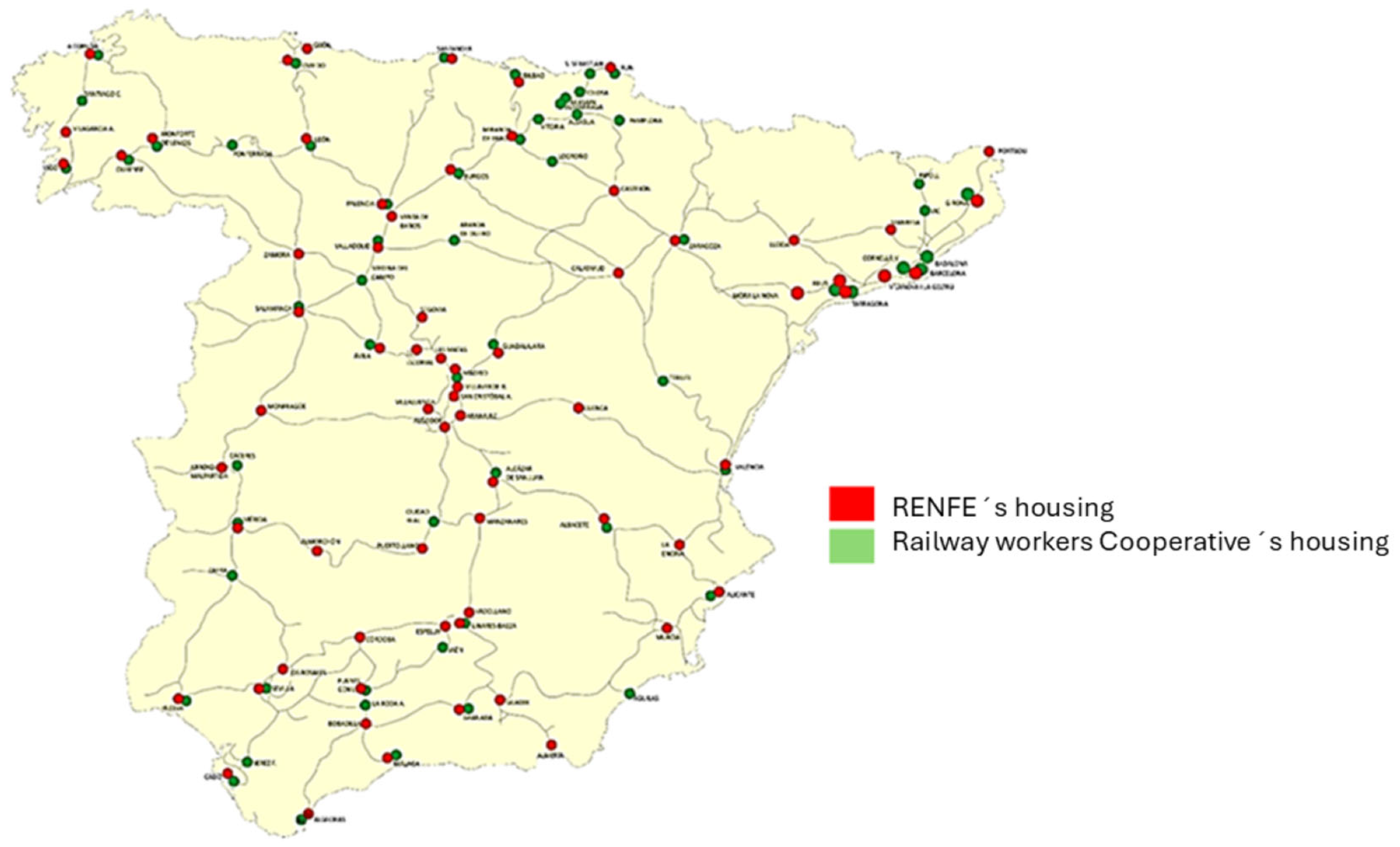
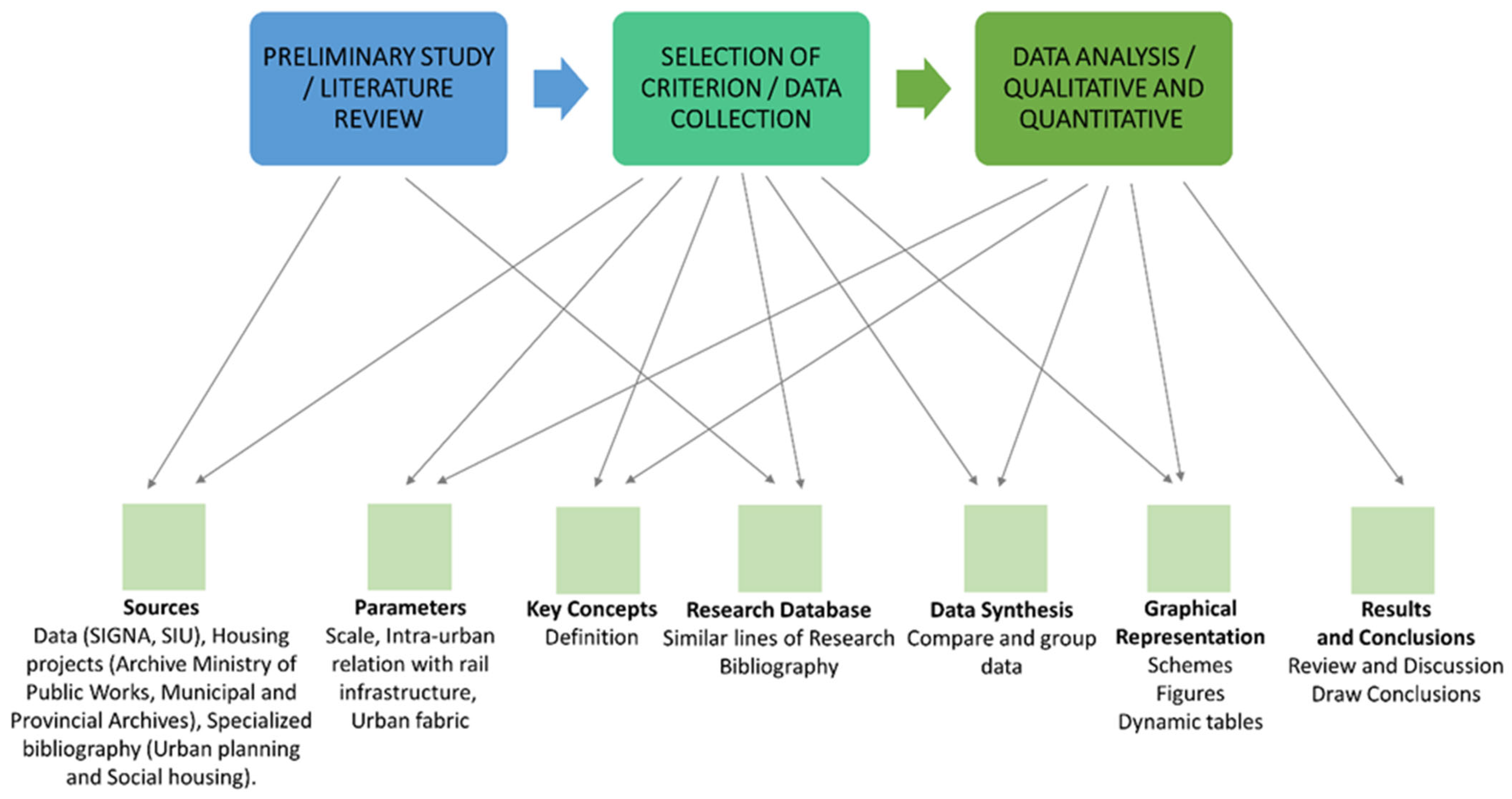
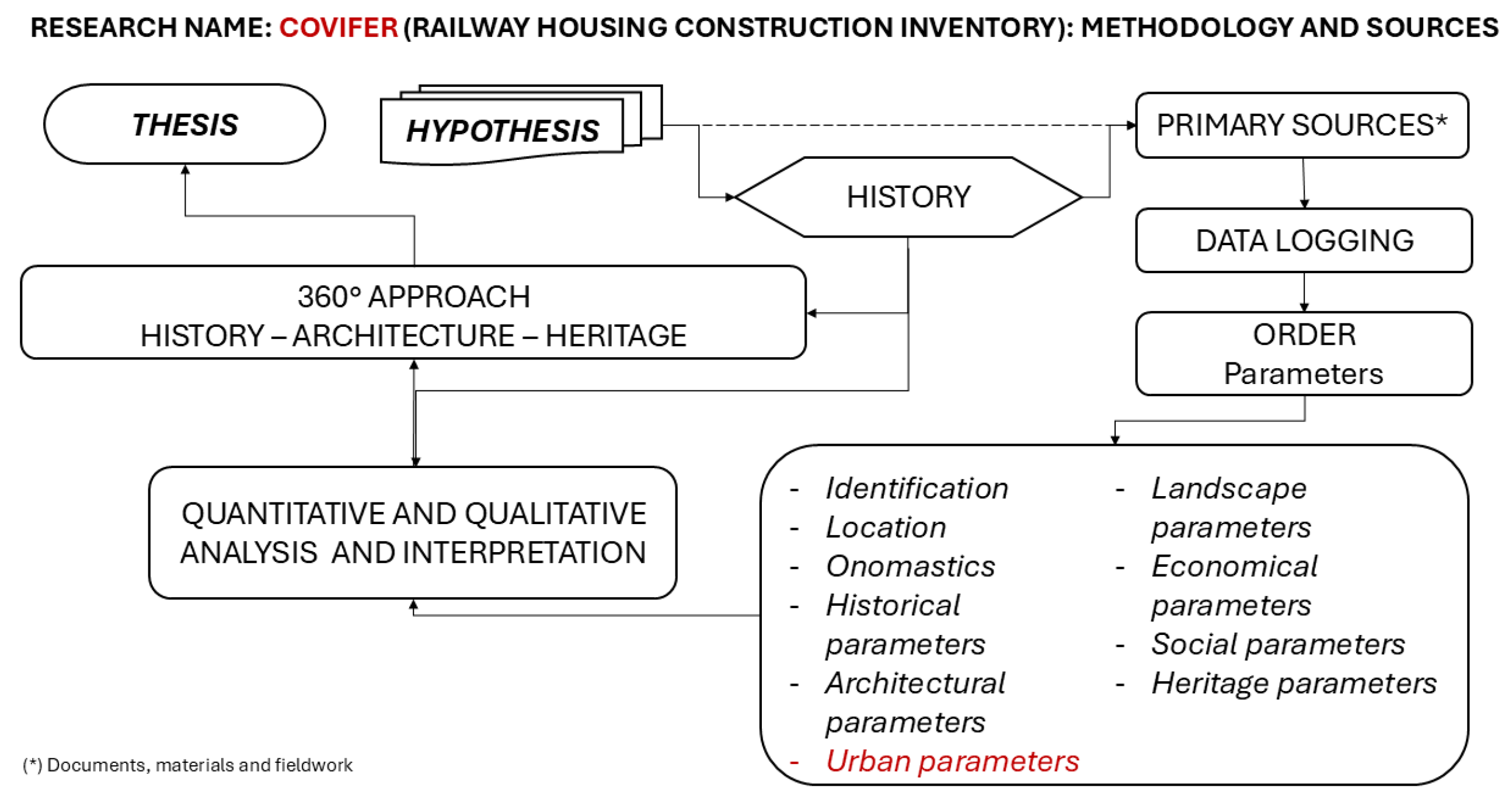
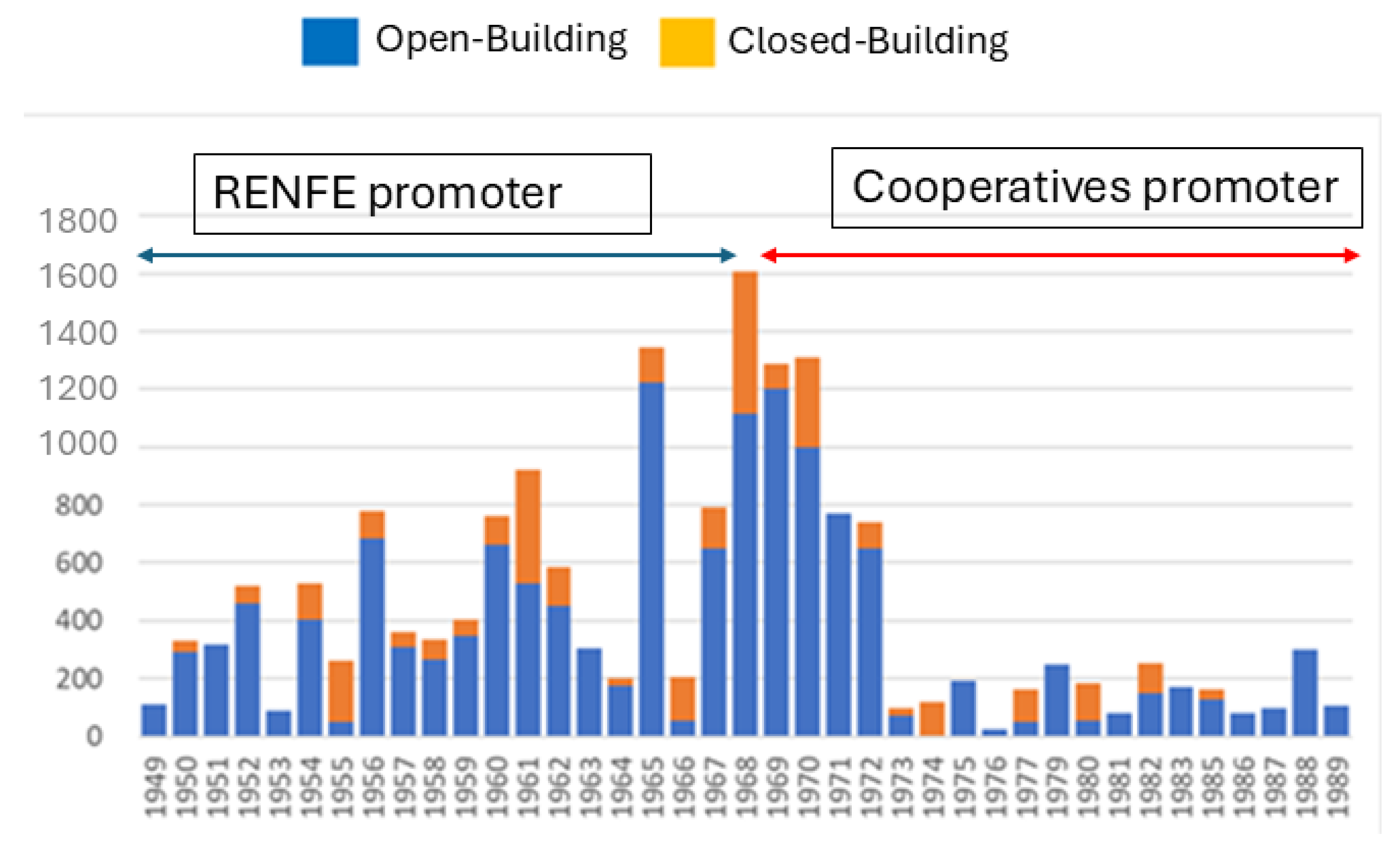
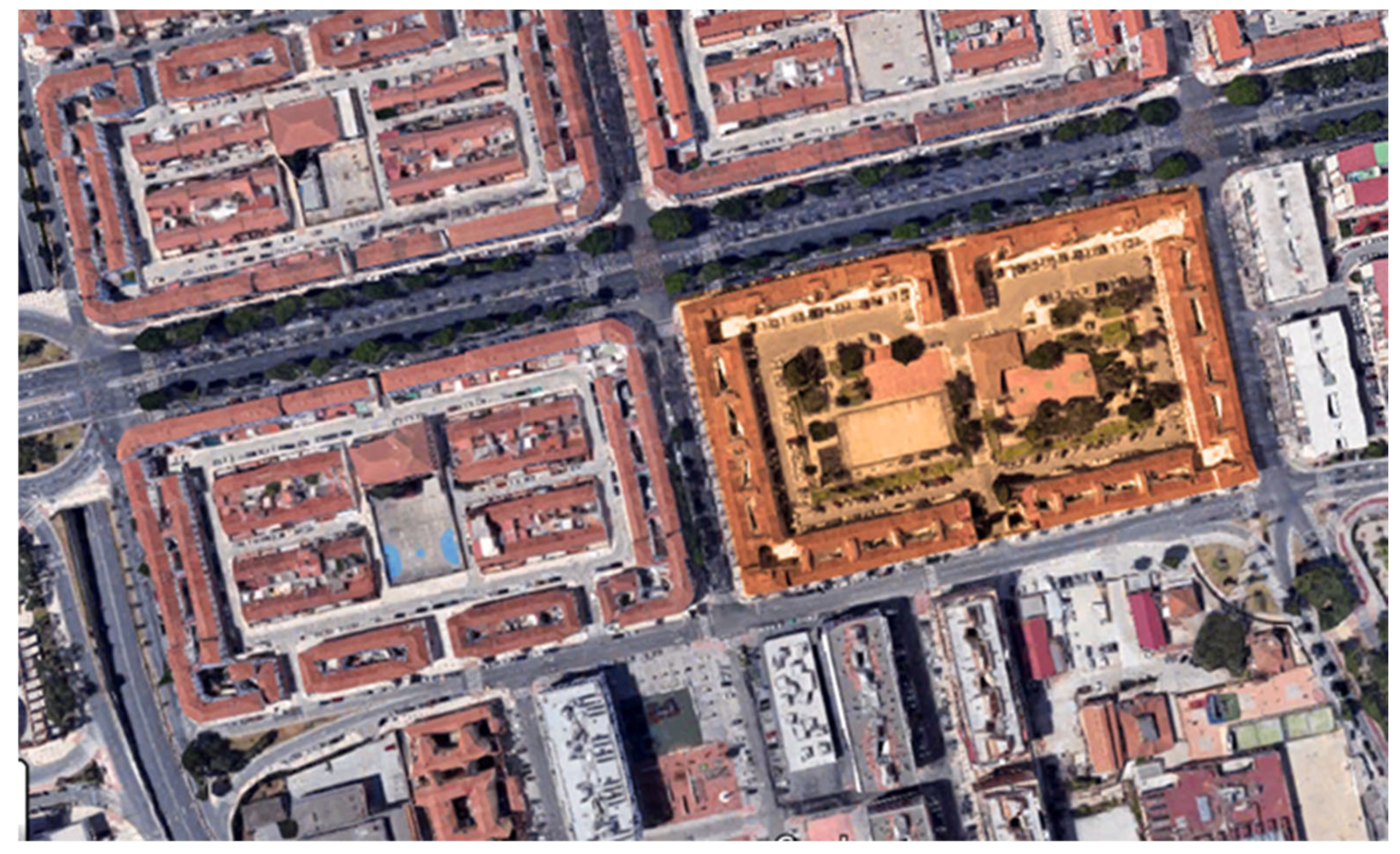
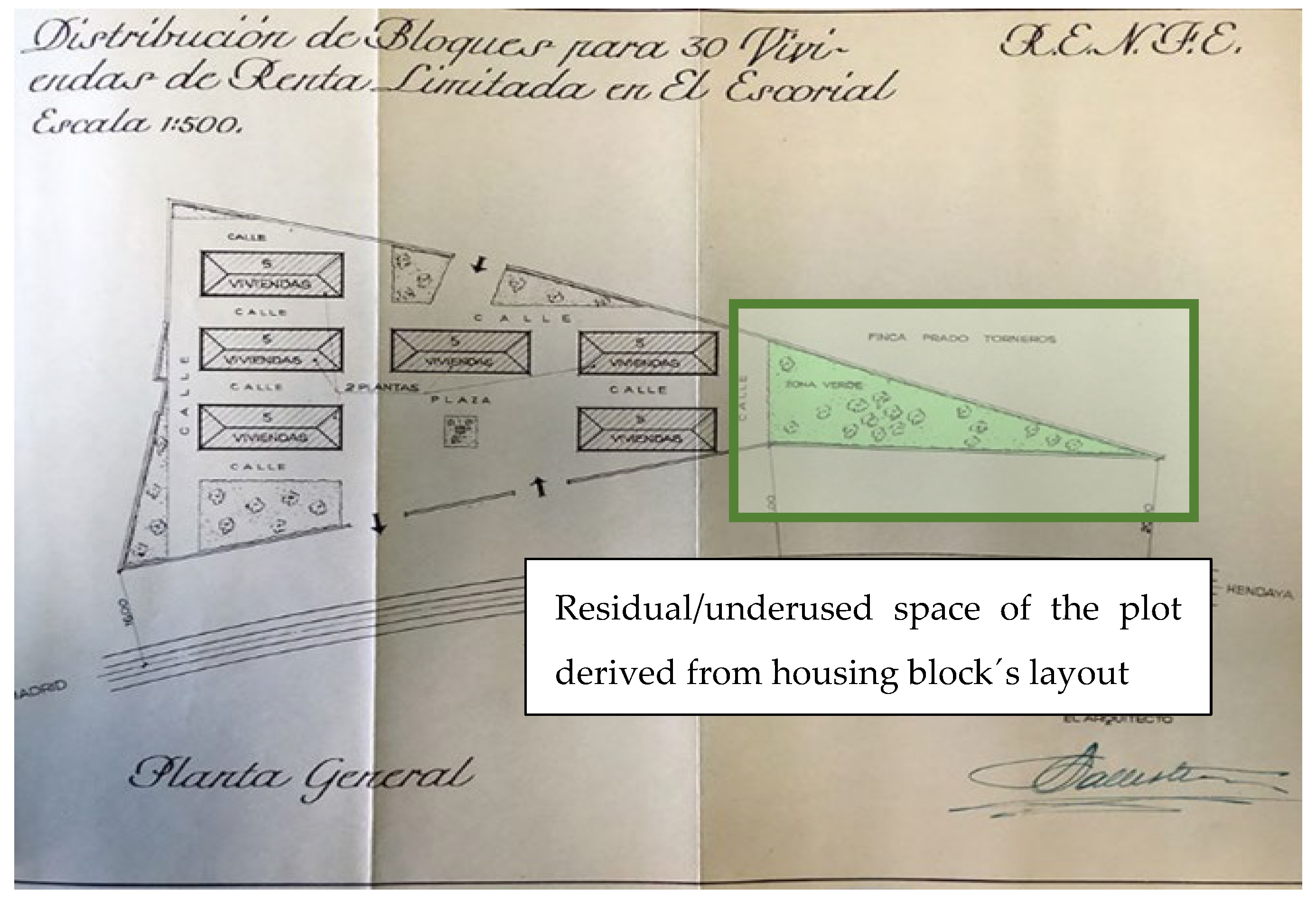
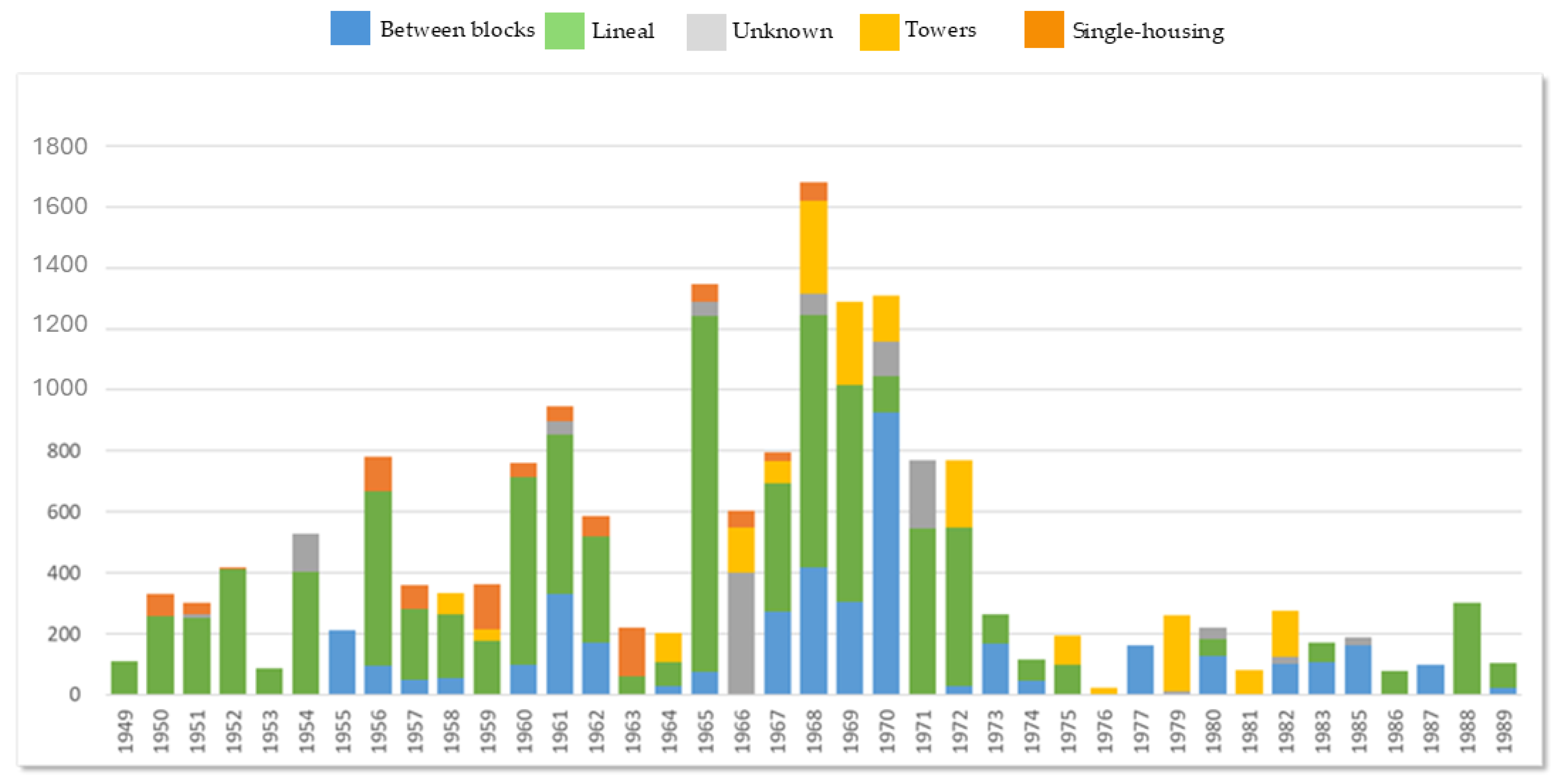
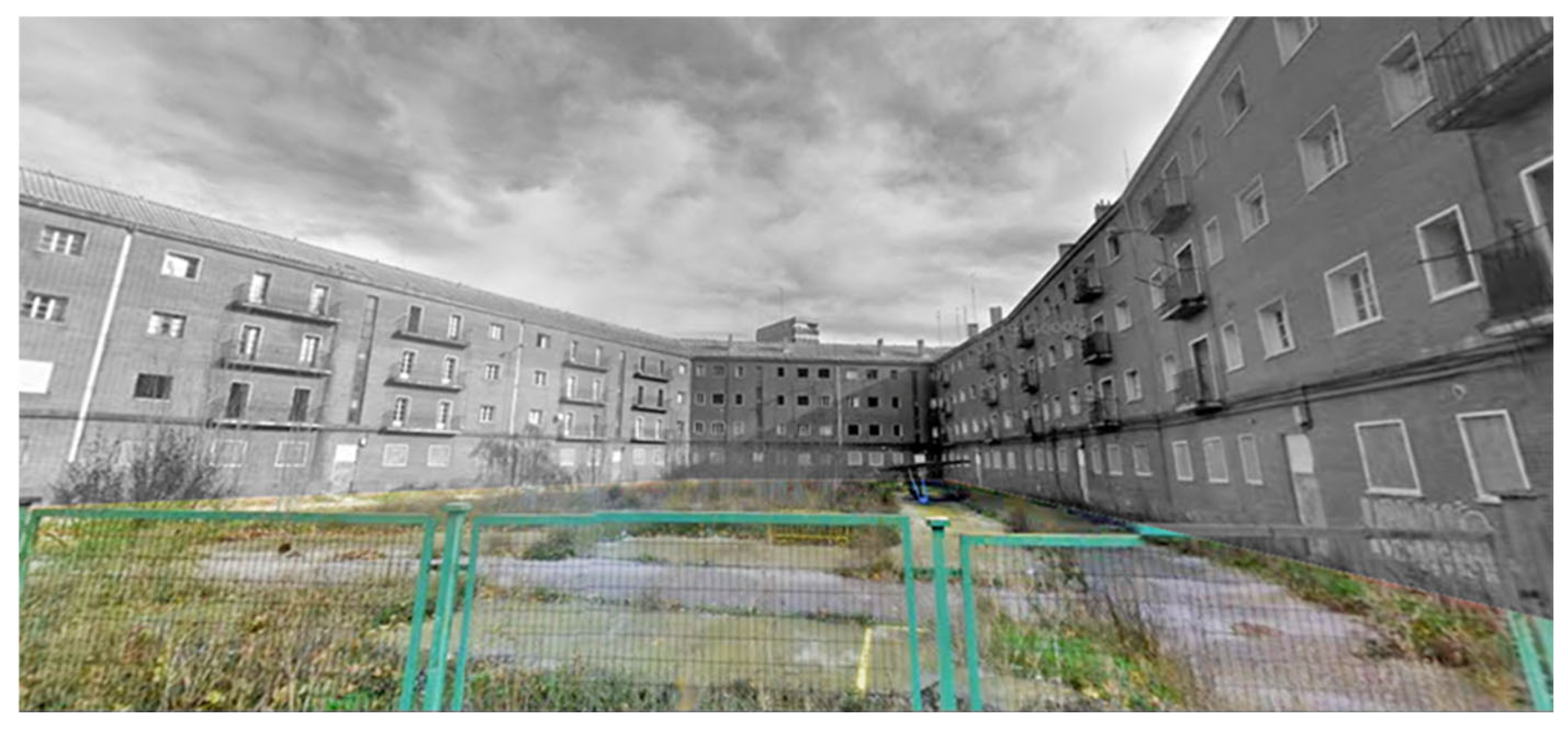
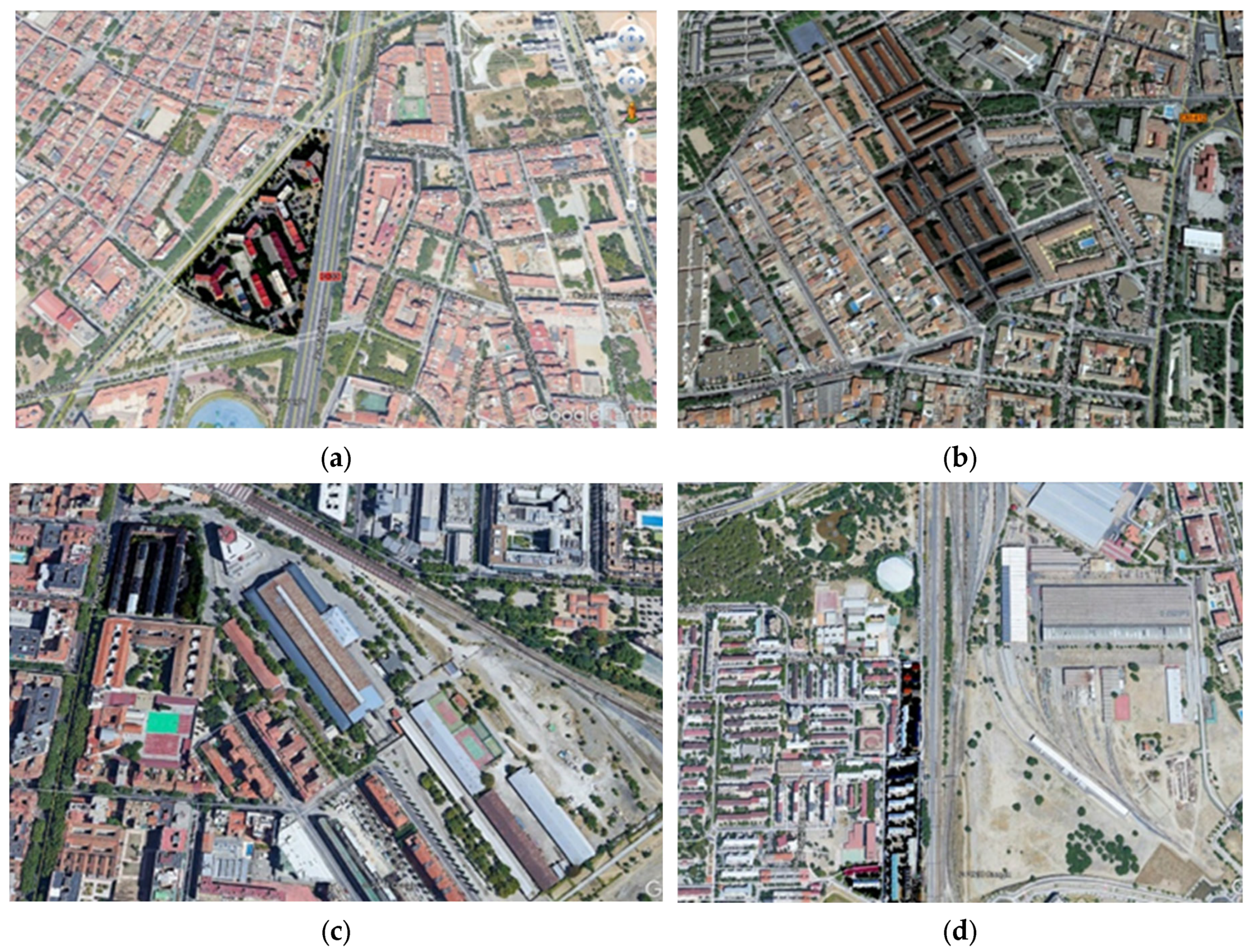
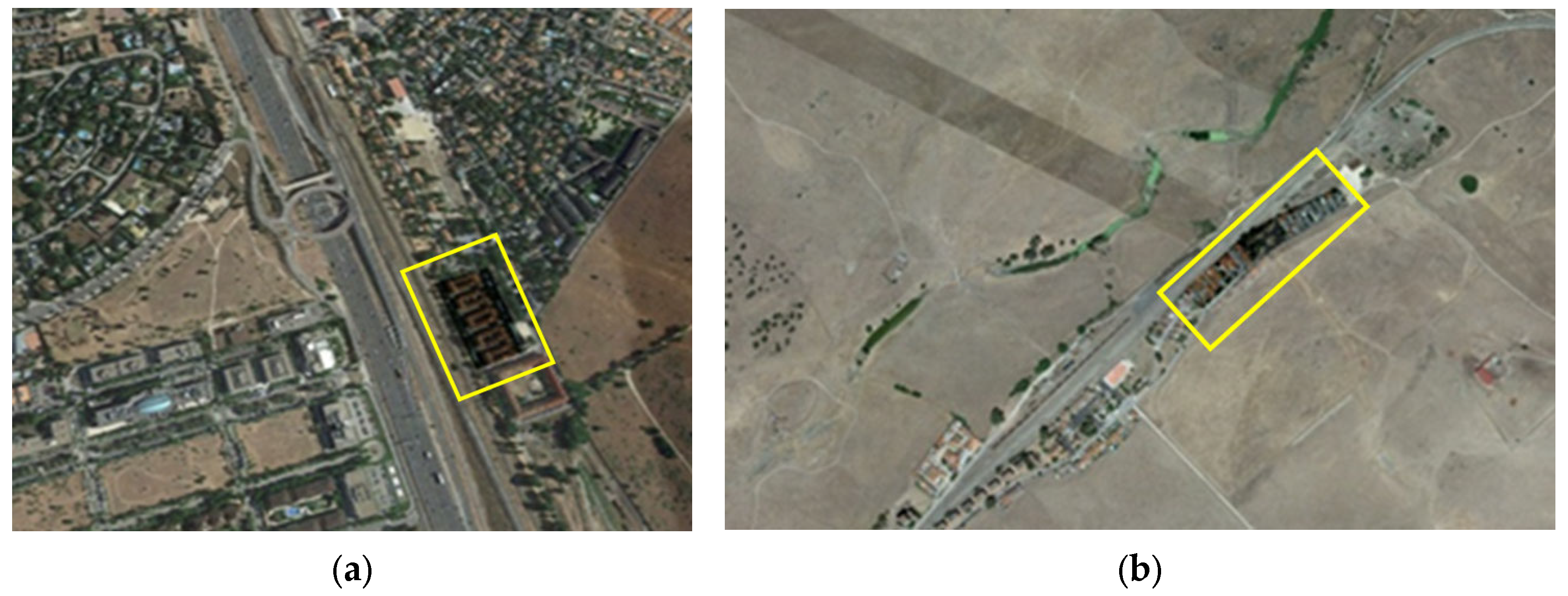
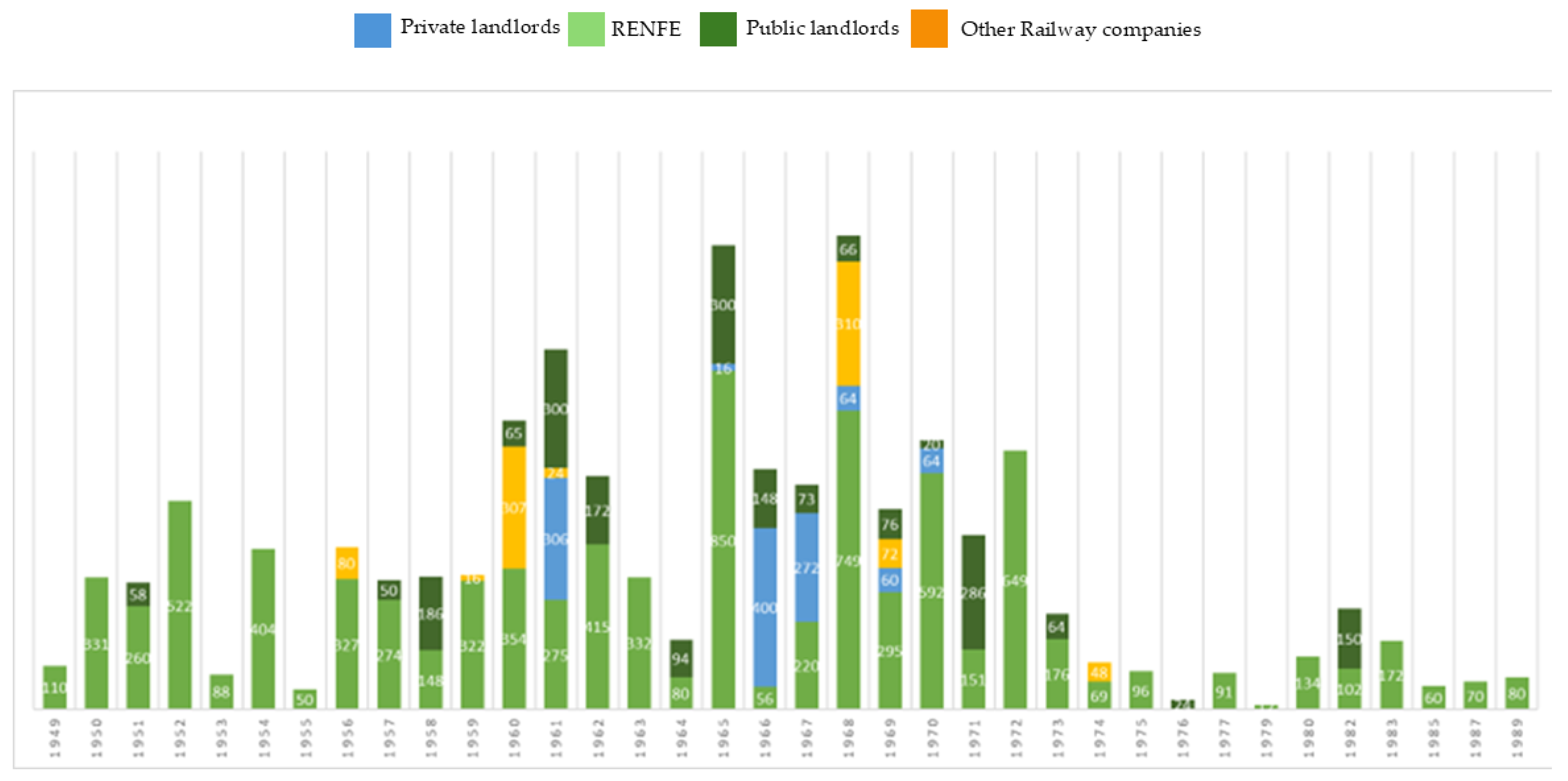
Disclaimer/Publisher’s Note: The statements, opinions and data contained in all publications are solely those of the individual author(s) and contributor(s) and not of MDPI and/or the editor(s). MDPI and/or the editor(s) disclaim responsibility for any injury to people or property resulting from any ideas, methods, instructions or products referred to in the content. |
© 2024 by the authors. Licensee MDPI, Basel, Switzerland. This article is an open access article distributed under the terms and conditions of the Creative Commons Attribution (CC BY) license (https://creativecommons.org/licenses/by/4.0/).
Share and Cite
Martínez-Corral, A.; Cuéllar, D.; Domínguez Rodrigo, T.L. Analysis of the Urban Transformations Derived from Railway Housing Construction in Spain During Francoism (1939–1975): An Underestimated Heritage in Use. Heritage 2024, 7, 6480-6498. https://doi.org/10.3390/heritage7110301
Martínez-Corral A, Cuéllar D, Domínguez Rodrigo TL. Analysis of the Urban Transformations Derived from Railway Housing Construction in Spain During Francoism (1939–1975): An Underestimated Heritage in Use. Heritage. 2024; 7(11):6480-6498. https://doi.org/10.3390/heritage7110301
Chicago/Turabian StyleMartínez-Corral, Aurora, Domingo Cuéllar, and Tomás L. Domínguez Rodrigo. 2024. "Analysis of the Urban Transformations Derived from Railway Housing Construction in Spain During Francoism (1939–1975): An Underestimated Heritage in Use" Heritage 7, no. 11: 6480-6498. https://doi.org/10.3390/heritage7110301
APA StyleMartínez-Corral, A., Cuéllar, D., & Domínguez Rodrigo, T. L. (2024). Analysis of the Urban Transformations Derived from Railway Housing Construction in Spain During Francoism (1939–1975): An Underestimated Heritage in Use. Heritage, 7(11), 6480-6498. https://doi.org/10.3390/heritage7110301






